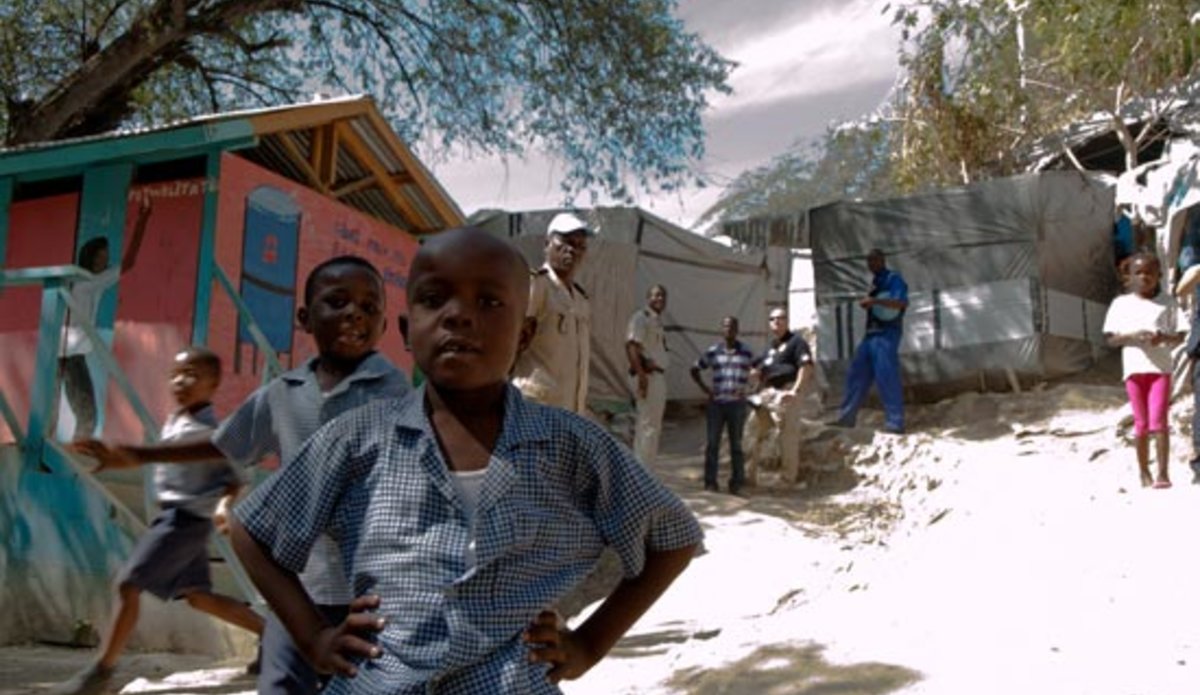MINUSTAH UNPols Protect IDP Camp Residents
Near Petionville, Haiti, there is an Internally Displaced Person (IDP) camp containing approximately 17,000 residents from 4,500 different families. The camp, which lies in a valley with tents, markets, and other signs of life, is the equivalent of many small cities and villages around the world. Within this IDP camp, there are two schools where children attend at no cost, two churches for worshipping, and a hospital is situated at the top of a hill. The guardians of this community are members of the Haitian National Police (HNP) and the United Nations Stabilization Mission in Haiti’s police (MINUSTAH UNPols).

|
Photo : UN/MINUSTAH |
On February 2, 2012, I toured this camp to report on the activity that goes on in daily life. The sights that greeted me were signs of hope. There were two schools with children separated by grades studying their lessons or playing at recess. At one school, aptly named “Ecole de L’espoir” or “School of Hope,” a group of girls was skipping jump ropes while their peers held the ends and the boys played soccer. All of the children, scrubbed clean and immaculately dressed in their uniforms, created a setting worthy of Mark Twain’s “Huckleberry Finn.” They all laughed, smiled, played, and learned in a setting free of fear.

The catalyst of this climate of safety and security is observable in the operation and interaction of the HNP and UNPols. According to Deputy Team Leader, Alain Parfait Chadaton, 19 UNPols staff the camp each 24-hour period in conjunction with 6 HNP officers. A small administrative center is located along with a newly constructed “Welcome Center” for victims of gender-based violence facilitated by MINUSTAH Gender personnel. This office will be jointly staffed with HNP and UNPol, Haiti’s Ministry of Women’s Condition and Women’s Rights (MCFDF), as well as camp residents to address gender crime issues.
In addition to the HNP and UNPol patrols, 52 solar powered lights spaced through the 5 sectors of the camp enhance security. A camp committee, whose members are vetted by the Office of International Migration (OIM), works with the HNP and UNPols in a neighborhood watch and advisory capacity. The President of the committee, Raynald Romelus, accompanied the group through the camp.
The working relationship between the HNP and UNPols “has been very good,” according to UNPol Rachelle Redmond, one of seven IDP Camp Coordinators. The HNP officers assigned to the camp are willing to work and help the residents, as well as work with MINUSTAH personnel. These officers conduct foot patrols with UNPols and take the lead in camp security efforts.
 Touring the camp by foot required approximately one hour. This circumambulation took the group up the sides of steep hills and down into narrow grades. At all stops along the way, the UNPols and HNP officers stopped and visited with local camp residents. The attitudes of the residents were cheerful, and they were grateful for the assistances paid to them. I was invited to visit the elementary schools and met a number of young boys and girls in different grades who were attending their lessons. Other than the location, the classrooms could have been a replica of those anywhere else in the world. This writer could have spent the day watching the lessons being taught, but alas, the groups’ presence was a distraction to the children. Rather than see them be scolded for being curious about the newcomers, we pressed onward to other areas.
Touring the camp by foot required approximately one hour. This circumambulation took the group up the sides of steep hills and down into narrow grades. At all stops along the way, the UNPols and HNP officers stopped and visited with local camp residents. The attitudes of the residents were cheerful, and they were grateful for the assistances paid to them. I was invited to visit the elementary schools and met a number of young boys and girls in different grades who were attending their lessons. Other than the location, the classrooms could have been a replica of those anywhere else in the world. This writer could have spent the day watching the lessons being taught, but alas, the groups’ presence was a distraction to the children. Rather than see them be scolded for being curious about the newcomers, we pressed onward to other areas.
In this environment of safety and security, it appears that in spite of less than ideal conditions, a society is existing in harmony with a positive mindset and attitude. The human condition is capable of noble exertions and with the assistance of the HNP and MINUSTAH UNPols, Haitian citizens are empowered to overcome their adversity. Thus, the conclusion of this tour left the writer with a positive impression that good things are taking place within this camp by those dedicated to the guardianship of the small city’s citizens.
ARTICLE WRITTEN BY: Billy Young- MINUSTAH UNPol Journalist
PICTURES TAKEN BY: Sergio Daniel Gonzales- MINUSTAH UNPol-Photographer
 ONU
ONU Nations Unies Maintien de la paix
Nations Unies Maintien de la paix


